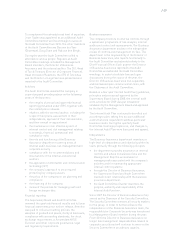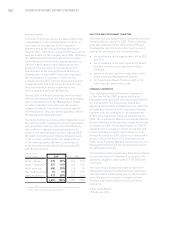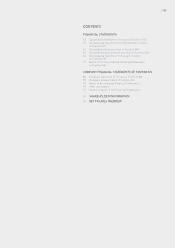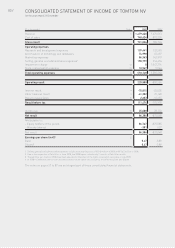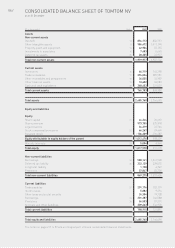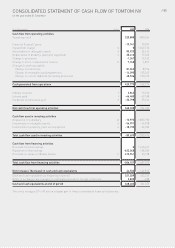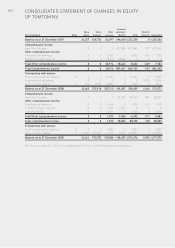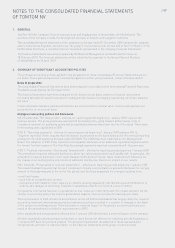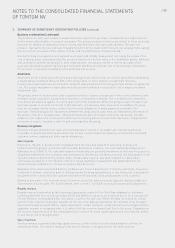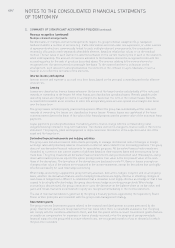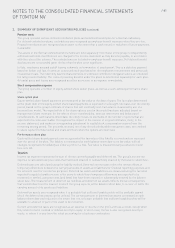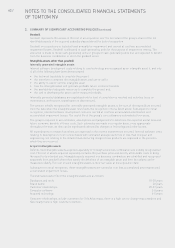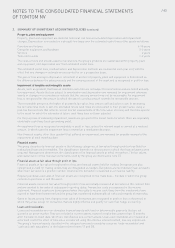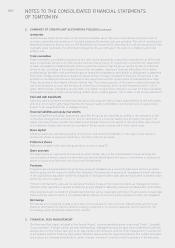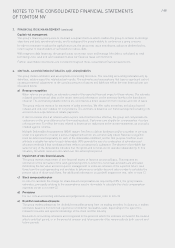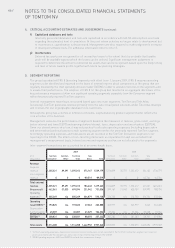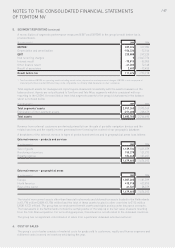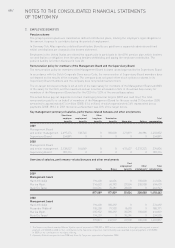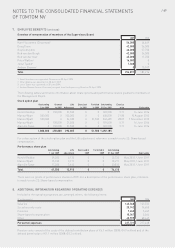TomTom 2009 Annual Report Download - page 61
Download and view the complete annual report
Please find page 61 of the 2009 TomTom annual report below. You can navigate through the pages in the report by either clicking on the pages listed below, or by using the keyword search tool below to find specific information within the annual report.
/ 59
NOTES TO THE CONSOLIDATED FINANCIAL STATEMENTS
OF TOMTOM NV
2. SUMMARY OF SIGNIFICANT ACCOUNTING POLICIES (continued)
Business combinations (continued)
The provision for earn-outs relates to acquisitions where part of the purchase consideration is a future earn out
for the former shareholders of acquired companies. The group provides for future costs related to these earn-outs
based on (or related to) estimates of future results that determine the future cash outflows. The earn-out
provision represents the best estimate of payments which will be made under the earn-out arrangements, taking
into account the provisions of the related contract and the performance criteria included.
Goodwill arising on acquisition is recognised as an asset and initially measured at cost, being the excess of the
cost of the business combination over the group’s interest in the net fair value of the identifiable assets, liabilities
and contingent liabilities recognised. If, after reassessment, the group’s interest in the net fair value of the
acquiree’s identifiable assets, liabilities and contingent liabilities exceeds the cost of the business combination,
the excess is recognised immediately in the profit and loss account.
Associates
Associates are all entities over which the group has significant influence but not control, generally accompanying
a shareholding of between 20% and 50% of the voting rights, or other evidence of significant influence.
Investments in associates are accounted for using the equity method of accounting, and are initially recognised at
cost. The group’s investment in associates includes goodwill identified on acquisition, net of any accumulated
impairment loss.
The group’s share of its associates’ post-acquisition profits or losses is recognised in the income statement, and
its share of post-acquisition movements in reserves is recognised in reserves. The cumulative post-acquisition
movements are adjusted against the carrying amount of the investment. When the group’s share of losses in an
associate equals or exceeds its interest in the associate, including any other unsecured receivables, the group
does not recognise further losses, unless it has incurred obligations or made payments on behalf of the
associate. Unrealised gains on transactions between the group and its associates are eliminated to the extent of
the group’s interest in the associates. Unrealised losses are also eliminated, unless the transaction provides
evidence of an impairment of the asset transferred. Accounting policies of associates have been changed where
necessary to ensure consistency with the policies adopted by the group.
Revenue recognition
Revenue is measured as the fair value of the consideration received or receivable and represents amounts
receivable for goods and services provided in the normal course of business. Revenue is reduced for estimated
customer returns, rebates and other similar allowances.
Sale of goods
Revenue on the sale of goods is only recognised when the risks and rewards of ownership of goods are
transferred to the group’s customers (which include distributors, retailers, end-users and Original Equipment
Manufacturers (“OEMs”)). The risks and rewards of ownership are generally transferred at the time the product is
shipped and delivered to the customer and, depending on the delivery conditions, title and risk have passed to the
customer and acceptance of the product, when contractually required, has been obtained. In cases where
contractual acceptance is not required, revenue is recognised when management has established that all
aforementioned conditions for revenue recognition have been met.
Examples of the above-mentioned delivery conditions are ‘Free on Board point of delivery’ and ‘Costs, Insurance
Paid point of delivery’, where the point of delivery may be the shipping warehouse or any other point of destination
as agreed in the contract with the customer and where title and risk in the goods passes to the customer.
Estimates are made of the financial impact of returns, as well as sales incentives, based on historical data and
expectations of future sales. For further details, refer to note 4, Critical Accounting Estimates and Judgements.
Royalty revenue
Royalty revenue is generated by the licensing of geographic content of the Tele Atlas database to customers.
Licensing takes the form of selling products (CDs and DVDs) to end users for perpetual use or for a fixed period
of time. Revenue is recognised when the product is sold to the end-user. Where the data is licensed for a fixed
period of time, revenue recognition depends on the use of the data as reported by the customer or by the agent
when sold through an agent. Where royalty agreements contain minimum royalty amounts and arrangements for
upgrades, revenue is recognised when it is certain that the economic benefit will flow to the group. Depending on
the revenue characteristics of the related agreement, revenue on these royalty agreements is recognised upfront
or over the period of the agreement.
Sale of services
Services revenue is generated by map update services, content sales and connected navigation services for
commercial fleets. The revenue relating to the service element is recognised over the service period.


